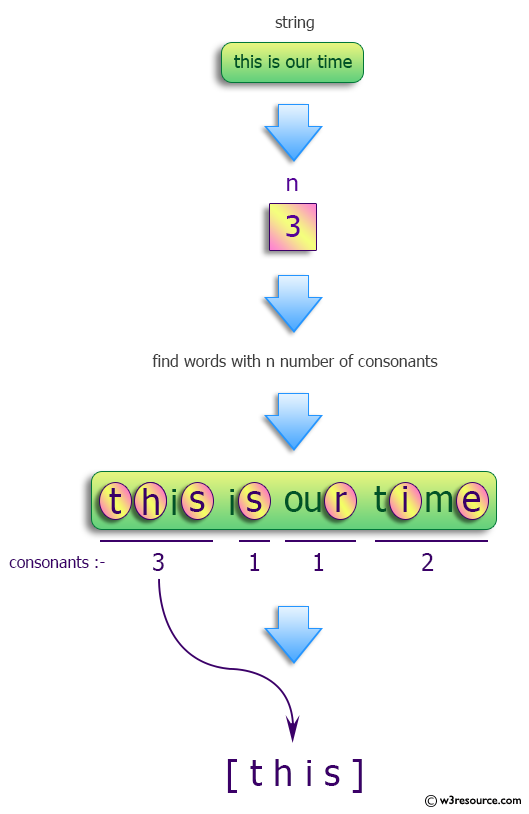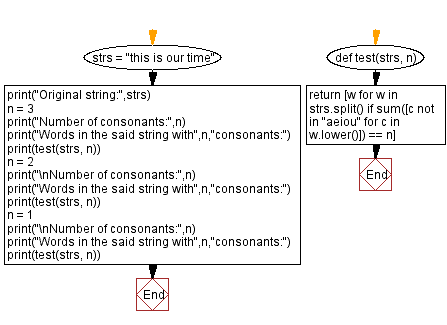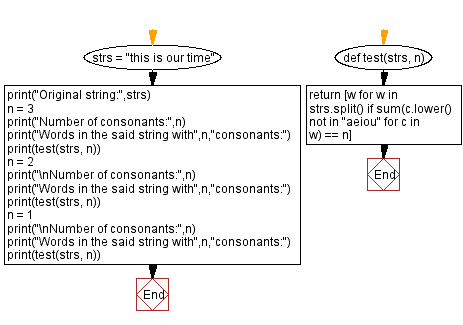Python: Find all words in a given string with n consonants
Python Programming Puzzles: Exercise-43 with Solution
From vocabulary.com:
A consonant is a speech sound that is not a vowel. It also refers to letters of the alphabet that represent those sounds: Z, B, T, G, and H are all consonants. Consonants are all the non-vowel sounds, or their corresponding letters: A, E, I, O, U and sometimes Y are not consonants.
Write a Python program to find all words in a given string with n consonants.
Input: this is our time Output: Number of consonants: 3 Words in the said string with 3 consonants: ['this'] Number of consonants: 2 Words in the said string with 2 consonants: ['time'] Number of consonants: 1 Words in the said string with 1 consonants: ['is', 'our']
Pictorial Presentation:

Sample Solution-1:
Python Code:
#License: https://bit.ly/3oLErEI
def test(strs, n):
return [w for w in strs.split() if sum([c not in "aeiou" for c in w.lower()]) == n]
strs = "this is our time"
print("Original string:",strs)
n = 3
print("Number of consonants:",n)
print("Words in the said string with",n,"consonants:")
print(test(strs, n))
n = 2
print("\nNumber of consonants:",n)
print("Words in the said string with",n,"consonants:")
print(test(strs, n))
n = 1
print("\nNumber of consonants:",n)
print("Words in the said string with",n,"consonants:")
print(test(strs, n))
Sample Output:
Original string: this is our time Number of consonants: 3 Words in the said string with 3 consonants: ['this'] Number of consonants: 2 Words in the said string with 2 consonants: ['time'] Number of consonants: 1 Words in the said string with 1 consonants: ['is', 'our']
Flowchart:

Visualize Python code execution:
The following tool visualize what the computer is doing step-by-step as it executes the said program:
Sample Solution-2:
Python Code:
def test(strs, n):
return [w for w in strs.split() if sum(c.lower() not in "aeiou" for c in w) == n]
strs = "this is our time"
print("Original string:",strs)
n = 3
print("Number of consonants:",n)
print("Words in the said string with",n,"consonants:")
print(test(strs, n))
n = 2
print("\nNumber of consonants:",n)
print("Words in the said string with",n,"consonants:")
print(test(strs, n))
n = 1
print("\nNumber of consonants:",n)
print("Words in the said string with",n,"consonants:")
print(test(strs, n))
Sample Output:
Original string: this is our time Number of consonants: 3 Words in the said string with 3 consonants: ['this'] Number of consonants: 2 Words in the said string with 2 consonants: ['time'] Number of consonants: 1 Words in the said string with 1 consonants: ['is', 'our']
Flowchart:

Visualize Python code execution:
The following tool visualize what the computer is doing step-by-step as it executes the said program:
Python Code Editor :
Have another way to solve this solution? Contribute your code (and comments) through Disqus.
Previous: Find the set of distinct characters in a string, ignoring case.
Next: Determine which characters of a hexadecimal number correspond to prime numbers.
What is the difficulty level of this exercise?
Test your Programming skills with w3resource's quiz.
Python: Tips of the Day
Find current directory and file's directory:
To get the full path to the directory a Python file is contained in, write this in that file:
import os dir_path = os.path.dirname(os.path.realpath(__file__))
(Note that the incantation above won't work if you've already used os.chdir() to change your current working directory, since the value of the __file__ constant is relative to the current working directory and is not changed by an os.chdir() call.)
To get the current working directory use
import os cwd = os.getcwd()
Documentation references for the modules, constants and functions used above:
- The os and os.path modules.
- The __file__ constant
- os.path.realpath(path) (returns "the canonical path of the specified filename, eliminating any symbolic links encountered in the path")
- os.path.dirname(path) (returns "the directory name of pathname path")
- os.getcwd() (returns "a string representing the current working directory")
- os.chdir(path) ("change the current working directory to path")
Ref: https://bit.ly/3fy0R6m
- New Content published on w3resource:
- HTML-CSS Practical: Exercises, Practice, Solution
- Java Regular Expression: Exercises, Practice, Solution
- Scala Programming Exercises, Practice, Solution
- Python Itertools exercises
- Python Numpy exercises
- Python GeoPy Package exercises
- Python Pandas exercises
- Python nltk exercises
- Python BeautifulSoup exercises
- Form Template
- Composer - PHP Package Manager
- PHPUnit - PHP Testing
- Laravel - PHP Framework
- Angular - JavaScript Framework
- Vue - JavaScript Framework
- Jest - JavaScript Testing Framework
